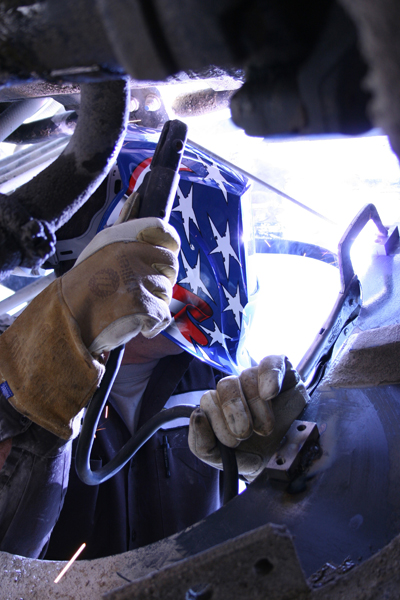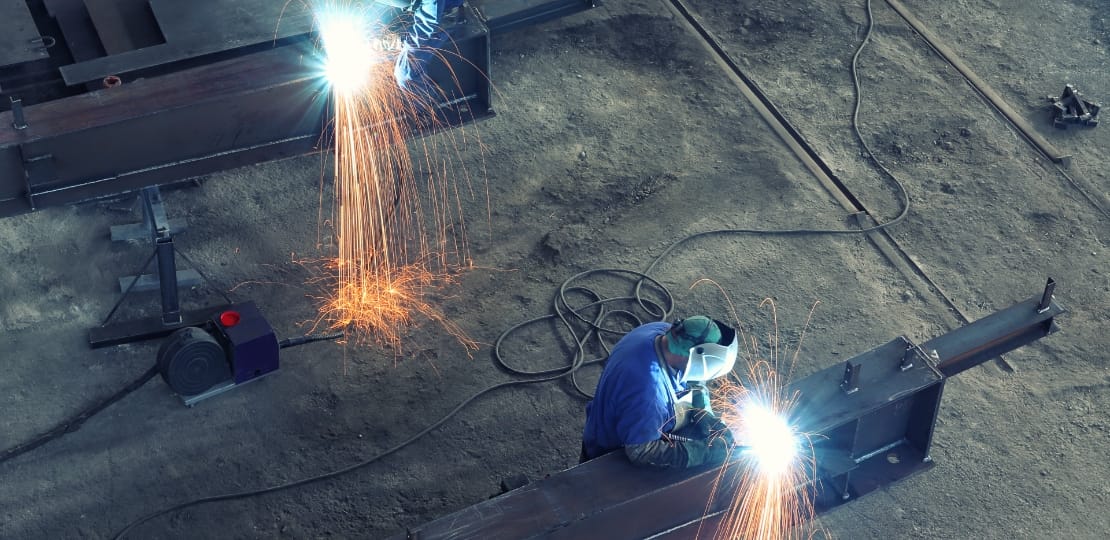Typical Welding Repair Work Issues and How to Address Them Successfully
Welding repair services often encounter a variety of concerns that can endanger the integrity of the final item. Common problems include insufficient penetration, porosity, and misalignment, to name a few. Each issue provides unique difficulties that call for certain methods for resolution. Understanding these concerns is important for welders intending to improve their skills and results. This discussion will certainly check out these typical welding repair service problems and efficient methods to address them.
Poor Penetration
Insufficient infiltration happens when the weld steel falls short to fully fuse with the base product, causing weak joints and potential structural failures. This issue often originates from inadequate warmth input, inaccurate electrode angle, or inappropriate welding speed. Welders might experience inadequate penetration as a result of a miscalculation of the required specifications for a certain material thickness or kind. In addition, contamination on the base material's surface can hinder reliable bonding, worsening the problem. To address poor penetration, welders ought to guarantee proper setups on their tools and keep a tidy work surface. Routine examination of welds is suggested to identify any kind of shortages early, permitting prompt corrections and the avoidance of endangered structural integrity in welded settings up.
Porosity
Porosity is a common issue in bonded joints that shows up as small gas bubbles trapped within the weld metal. This problem can compromise the integrity of the weld, causing reduced toughness and prospective failing under stress and anxiety. Montana Mobile Welding and Repair. Porosity generally develops from contamination, moisture, or improper welding strategies, which permit gases to leave into the liquified weld swimming pool. To address porosity, welders must guarantee correct surface area prep work, preserve a tidy working environment, and make use of ideal welding parameters. Furthermore, choosing the best filler material and securing gas can alleviate gas entrapment. Routine assessment and testing of welds can help determine porosity early, assuring prompt restorative activities are taken, thus maintaining the top quality and reliability of the bonded framework
Imbalance
Misalignment in welding can arise from numerous variables, including improper setup and thermal development. Comprehending the source is important for effective resolution. Several modification methods are available to realign elements and ensure architectural stability.
Root causes of Imbalance
Welding imbalance often comes from a variety of underlying issues that can jeopardize structural stability. One key reason is improper fit-up of components before welding, which can bring about spaces and irregular surfaces. Variations in thermal expansion throughout the welding procedure can also result in distortion, specifically if the materials being joined have various coefficients of expansion. Furthermore, inadequate clamping and fixturing might stop working to hold elements firmly in place, leading to activity throughout welding. Badly maintained equipment, including welding machines and tools, may present inconsistencies in the weld grain, more contributing to imbalance. Operator mistake, stemming from inadequate training or experience, can additionally play a significant role in developing misaligned welds.

Correction Methods Offered
Attending to imbalance effectively requires a combination of rehabilitative methods customized to the particular problems at hand. One common technique is the use of jigs or fixtures to hold elements in the appropriate position during welding, ensuring regular placement. Additionally, pre-heating the materials can assist minimize distortion and enhance fit-up. For significant imbalance, mechanical realignment techniques, such as utilizing hydraulic jacks or clamps, can be employed to fix the position before welding. Post-weld warmth treatment might additionally be essential to relieve stress and anxieties triggered by imbalance. Careful inspection and adjustment during the arrangement phase can prevent misalignment problems from becoming significant troubles, advertising a smoother welding process and improving general structural stability.
Distortion
Distortion is an usual difficulty in welding that can occur from numerous factors, consisting of uneven heating and cooling. Comprehending the causes of distortion is important for implementing reliable avoidance methods. Resolving this concern not only boosts architectural honesty yet also boosts the total top quality of the weld.
Reasons of Distortion
When based on the extreme heat of welding, products usually undergo changes that can result in distortion. This sensation mainly arises from thermal growth and tightening during the welding process. As the weld area warms up, the product expands; upon air conditioning, it acquires, which can produce interior tensions. In enhancement, uneven heating throughout a work surface can intensify these tensions, causing bending or bending. The type of product also plays a considerable function; steels with varying thermal conductivity and coefficients of development might react in different ways, leading to unforeseeable distortions. Poor joint design and inadequate fixturing can add to misalignment throughout welding, raising the possibility of distortion. Understanding these causes is essential for efficient welding fixing and prevention strategies.
Prevention Techniques
Efficient prevention techniques for distortion throughout welding emphasis on regulating warmth input and making certain correct joint design. Maintaining a regular heat input helps to decrease thermal expansion and contraction, which can cause distortion. Utilizing techniques such as pre-heating the workpiece can additionally minimize the temperature level gradient, advertising consistent heating. Additionally, choosing ideal joint styles, such as T-joints or lap joints, can boost stability and reduce stress and anxiety focus. Executing correct fixturing to safeguard the workpieces in position further aids in maintaining placement during the welding procedure. Ultimately, staggered welding series can disperse warmth more uniformly, protecting against local distortion. By applying these methods, welders can significantly reduce the likelihood of distortion and enhance the general quality of their welds.
Breaking
Fracturing is a common issue experienced in welding repair services, typically arising from various variables such as inappropriate cooling prices, material selection, or insufficient joint preparation. The event of cracks can considerably endanger the integrity of the weld, causing possible failures throughout operation. To resolve this problem, welders should initially examine the origin, guaranteeing that materials work and appropriately chosen for the details application. In addition, controlling the air conditioning rate throughout the welding process is important; quick air conditioning can induce tension and lead to splitting. Correct joint layout and prep work also add to decreasing the risk. Carrying out these strategies can enhance weld quality and sturdiness, inevitably this post decreasing the chance of splitting in finished weldments.

Incomplete Fusion
A significant concern in welding repairs is insufficient blend, which occurs when the weld metal does not appropriately bond with the base product or previous weld passes - Belgrade Fabrication. This issue can bring about weak points in the joint, potentially endangering the honesty of the welded framework. Elements adding to insufficient combination include inadequate warm input, improper welding method, and contamination of the surface areas being signed up with. To address this concern properly, welders should guarantee proper pre-weld cleansing and surface area prep work, in addition to readjust their welding criteria to accomplish ample penetration and blend. Normal inspection during the welding process can also help identify insufficient fusion early, enabling prompt restorative measures to improve the total top quality of the weld
Overheating
While welding repair services can boost structural honesty, overheating presents a significant difficulty that can cause product destruction. Excessive warm throughout welding can modify the mechanical residential properties of metals, causing minimized stamina, boosted brittleness, and bending. This sensation is specifically critical in high-stress applications where structural reliability is critical. Determining getting too hot can include visual examinations for staining or distortion, as well as keeping track of temperature level during the welding procedure. To minimize the threats connected with getting too hot, welders must employ suitable strategies, such as controlling heat input, adjusting travel rate, and making use of appropriate filler materials. Additionally, executing pre- and post-weld heat treatments can assist restore material residential or commercial properties and improve the general high quality of the repair service, making sure long-term efficiency and safety.
Frequently Asked Questions
What Are the Typical Signs of a Welding Problem?

How Can I Examine My Welds for Top quality?
To evaluate welds for top quality, one can utilize aesthetic examinations, ultrasonic testing, and radiographic techniques. Each method ensures architectural integrity, determines flaws, and validates adherence to defined standards, eventually boosting the integrity of the welded joints.
What Safety Precautions Should I Take While Welding?
When welding, one ought to prioritize security by using proper individual safety devices, making sure correct ventilation, safeguarding flammable materials away, maintaining a tidy office, and recognizing surroundings to prevent injuries and accidents.
Can I Repair a Weld Without Redesigning the Entire Joint?
Repairing a weld without renovating the entire joint is feasible, relying on the damage (Belgrade Welding). Techniques such as grinding, including filler material, or using a welding procedure can successfully deal with portable welders for sale particular imperfections while maintaining the surrounding framework
What Tools Are Important for Effective Welding Services?
Necessary tools for efficient welding fixings include a welding machine, cord brush, grinder, safety equipment, clamps, and filler materials. Each device plays an important duty in ensuring high quality and security throughout the repair service procedure. Porosity typically develops from contamination, wetness, or improper welding techniques, which allow gases to leave right into the molten weld swimming pool. Inadequately maintained equipment, including welding makers and devices, may present variances in the weld bead, more contributing to misalignment. When subjected to the intense heat of welding, materials commonly undergo modifications that can lead to distortion. Breaking is a common problem run into in welding repair work, usually resulting from numerous factors such as incorrect cooling go to the website rates, material selection, or poor joint prep work. A significant issue in welding fixings is incomplete blend, which takes place when the weld metal does not sufficiently bond with the base material or previous weld passes.